But even if Pilates is your workout, don’t give up your weight lifting or cardio just yet. While regular Pilates training can help improve overall body strength and muscle mass, there’s a limit to those gains, says Christine Sellers, NCPT, a certified Pilates instructor at Bridge Body Clinic and Training Center in Atlanta.
Even if your usual Pilates class leaves you a sweaty, shaking mess, your heart rate won’t be elevated long enough to reap the cardiovascular benefits.
It’s not just sweat and shaking. Pilates can increase balance, mobility and total body strength. But does it count as strength training? Answer: Yes and no.
While you can build strength and muscle by doing Pilates, it’s a great supplemental exercise—our experts say it shouldn’t replace a steady weight training routine. Here’s everything you need to know about when to use Pilates as strength training and when to mix it up.
Is Pilates Strength Training?
“You can absolutely build both muscle and strength with Pilates,” says Abby Suskin, CPT, certified personal trainer, certified BASI Pilates instructor, and founder of Pilates With Abs. “Pilates is a form of resistance training, meaning it’s a type of exercise that works against an external force to build muscle strength and endurance.”
With traditional strength training, that power comes from free weights or a barbell. In Pilates, your body weight, a reformer spring, or a resistance band can provide that resistance.
“A well-programmed Pilates class loads all major muscle groups and builds strength through low-impact, slow, sustained movements,” says Suskin.
The bottom line? With a regular, balanced Pilates regimen, you’ll increase total-body strength—especially if you work on equipment like a reformer.
Can Pilates Build Muscle and Strength?
Because Pilates is a bodyweight activity, “depending on the strength level you come in, you can get stronger and build muscle with mat exercise,” Sellers says.
According to Sellers, traditional Pilates exercises like shoulder bridges and push-ups can challenge the load and build strength. But once you reach a certain fitness level, it’s challenging to build more strength and muscle with those bodyweight-only movements, because heavier weights make your muscles stronger and the benefits of Pilates will flatten out over time.
Both Sellers and Suskin recommend adding light weights, loop bands, and other props to mat Pilates exercises to increase resistance and build more muscle mass once you’ve mastered the basics.
Benefits of Pilates for muscle building and strengthening
According to Suskin, Pilates is best for building the muscle and strength of your core, the deep abdominal muscles that support your spine.
“A Pilates class will focus on exercises that build core strength and endurance, and your teacher will instruct you to breathe at certain points during an exercise to activate your core muscles,” she says.
Traditional Pilates exercises target single-leg stretches and rolls to strengthen deep abdominal muscles, such as the transverse abdominis and obliques, which improve overall posture and mobility, helping to prevent injuries and lower back pain.
Pilates vs Cardio
You may work up a sweat during a great Pilates workout, but unfortunately that doesn’t count as cardio, Sellers says.
“Cardio is any type of movement that gets your heart rate up and keeps it there for long periods of time,” she explains. “There are signs that your heart rate will increase during a mat workout, but usually, it’s not long enough to really reap the benefits.”
For maximum cardio and metabolic benefits, you’re better off doing continuous aerobic activity like running or cycling, says Suskin.
Pilates vs. Weightlifting
Yes, you’ll get some strength benefits from doing Pilates, but lifting weights is the best way to build muscle, Suskin says.
“Strength is only one aspect of a Pilates workout, and the goal of weight lifting is to increase muscle mass. [hypertrophy] through gradually adding more weight and stress to the muscles over time,” Suskin says. “If your goal is to build strength using bodyweight and light weights, Pilates will help you get stronger,” she adds. But if you want to increase muscle size, she recommends a traditional strength training program.
Lifting weights is especially important as you get older, because lifting weights not only improves your strength but also your mobility, which can help prevent injuries, Sellers says.
With its emphasis on core strength and flexibility, “Pilates can be a great way to supplement that strength training and also help prevent injury,” adds Suskin.
“With Pilates you can build both muscle and strength. Pilates is a form of resistance training, meaning it’s a type of exercise that works against an external force to build muscle strength and endurance. -Abby Suskin, CPT
The best strength building Pilates move
1. Shoulder Bridge Leg Raise
Sellers say this Pilates staple strengthens your glutes, quads, core and arms while challenging your balance.

- Lie on your back with your knees bent and feet flat on the floor, hip-width apart.
- Hold a light dumbbell in each hand, palms facing up, and lower your arms by your sides.
- Press through your feet, squeezing your glutes and core to drive your hips toward the ceiling until you form a diagonal line from knees to hips to chest.
- As you reach the opposite arm overhead, straighten one leg in front of you, keeping your hips up and flat.
- Return your raised arm and leg back to the floor.
- Repeat 10 times on one arm and leg, then switch sides.
Increase the intensity by extending one leg in front of you and raising both arms above your head.
2. Double leg extension
Add a challenge to this light-weight basic staple.
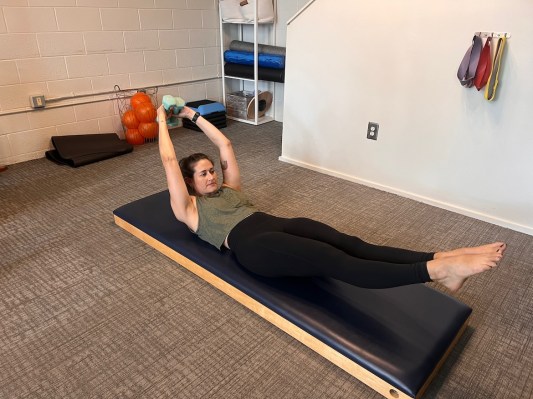
- Lie on your back with your legs extended.
- Hold a light dumbbell in each hand, palms facing up, and lower your arms by your sides.
- Pull your knees into your chest with your hands as you lift your head, neck and shoulders off the mat.
- Inhale and extend your legs to a 45-degree angle, reaching your arms overhead, and hold for a count of three.
- Exhale and bring your arms and legs back to the starting position.
- Repeat 10 times.
If you feel strain in your neck, remove the weight or lower your head to the mat.
3. Single leg extension
This arm and core burner works your internal and external obliques as well as your biceps and triceps.
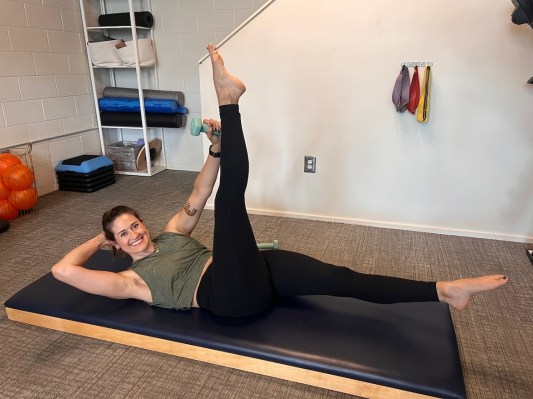
- Lie on your back with legs extended, place your right arm behind your head and extend your left arm down by your side, holding a weight in your left hand.
- Twist your head up, lift your legs to the ceiling, and twist your body to the right.
- Lower your left foot as your left hand reaches the outside of your right foot.
- Lift your shoulder blades off the mat, hold for three counts, then lower your head and lift your leg back up.
- Repeat 10 times on one side, then switch sides.
4. Clamshell plate
A combination of a clamshell and a plank, this full-body move works your glutes, hips, arms and obliques.
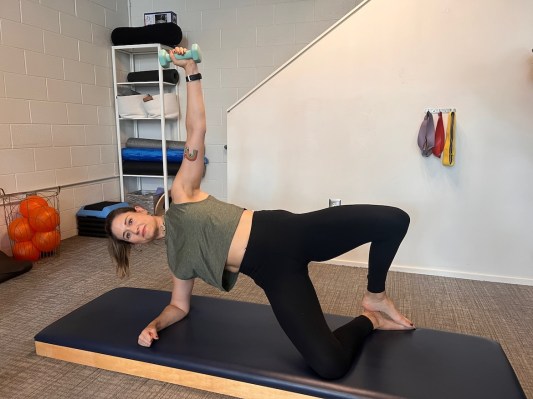
- Lie on your right side and lift your body up with your right forearm under your shoulder.
- Hold a light dumbbell in your left hand with your palm facing you.
- Bend your knees and place your legs on top of each other.
- Engage your lower hips and forearms to lift your upper body off the mat.
- With your feet together, open your upper hips toward the ceiling and raise your upper arm straight above you.
- Lower your arm and leg and repeat 10 times.
- Switch sides.
To reduce the intensity, remove the weight and/or keep your lower hips on the floor.
5. Pushing
This bodyweight exercise builds upper body strength by working muscles like your chest, arms and back.
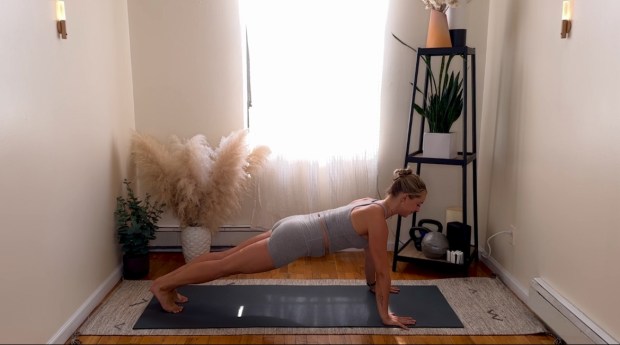
- Start in a high plank with your shoulders over your wrists, your pelvis tucked in, and your legs straight.
- Inhale as you bend your elbows 45 degrees to the side and slowly lower your body to the floor as far as you can without arching your lower back and losing your core connection.
- Pause for a moment at the “bottom” of the push.
- Exhale and engage your core as you press through your arms to push back to the starting position.
- Repeat 10 times.
6. Sideboard
This exercise will tone your curves, arms and hips while improving balance.

- Begin lying on your left side with your legs straight, feet bent, and legs stacked with your lower left forearm under your shoulder.
- Exhale as you lift the hips up, then hold for 10 to 30 seconds on each side, keeping your pelvis under to engage your core and support your lower back.
- Do 5 to 8 repetitions on one side, then repeat on the other side.
Change the exercise by keeping the knees bent and down on the mat.
7. Stretching the spine
This prone (your back) exercise works your posterior chain, or the muscles on the back side of your body.
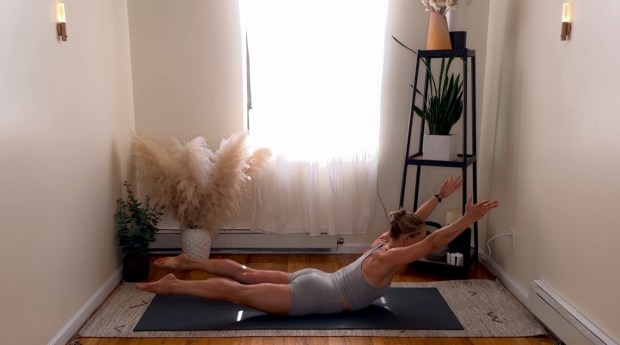
- Begin lying on your stomach with your hands under your shoulders, elbows tucked into your ribs, and legs straight out on the mat.
- Inhale through your pelvis to engage your core.
- At the same time, extend your arms straight out in front of you, biceps by your ears.
- Exhale and lift your head, chest, arms and legs off the mat.
- Hold for one breath, then exhale to lower back to the starting position.
- Repeat 10 times.
If you feel any tension in your lower back, place your feet on the mat and lift only your upper body.
8. Rolling over
In a traditional Pilates movement, roll-ups help mobilize your spine and build core strength.
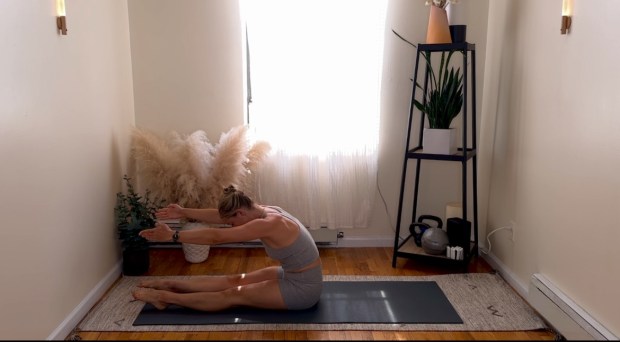
- Begin lying on your back with your legs straight and your arms overhead.
- Inhale to prepare, then exhale and curl your chin toward your chest, bringing your arms straight out in front of you as you slowly roll into an active forward bend.
- Inhale, reach toward your fingertips as you pull your belly button into your lower back.
- Exhale and roll down as slowly as possible one vertebra at a time until you are back on the mat.
- Repeat 10 times.
Bend your knees or use your hands behind your thighs for support as you roll up and down.
9. Bridge
A staple in Pilates and strength training classes, the bridge works your core, hamstrings and glutes while improving balance.

- Begin lying on your back, arms down by your sides, knees bent, feet flat on the floor, hip-width apart.
- Keep your pelvis in line with your spine to lift your hips and up off the mat as you inhale. Squeeze your glutes and core as you do so.
- Exhale to lower your hips and spine back to the mat.
- Repeat 10 times.
Add a weight or bar above your hips to add more weight and make the exercise more difficult.
The bottom line
Pilates is known for its slow, controlled movements, which are ideal for building core strength and improving mobility and balance. Those bodyweight movements help strengthen your arms, back, glutes, hips and hamstrings—to a point.
Building muscle requires more weight. For best results, incorporate weights or other resistance-type props into Pilates exercises, as listed above, and commit to a traditional strength training program at least twice a week.
#Pilates #count #strength #training #Set #record #straight #experts

